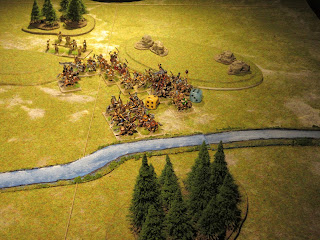Game One
The Gepid army formed their line at the base of long
difficult hill anchoring their left flank on the river. Due to the constricted
nature of the terrain, the Tervingi formed deep columns requiring time to form
their own battleline. Despite their laboring through the formation change, the
Tervingi held the initiative and attacked.
Gepid sloth quickly dissipated as they easily
countered every assault. The Gepid warband held well enough for the cavalry to
cut down Tervingi warband. Score 5 – 1 for the Gepid.
Game Two
Taking advantage of the heights, the Tervingi formed
their infantry along the hill crest with the cavalry extending the line from
the base of the hill. The Gepid forming three columns would form a battleline
beyond the wood.
Impatient at the progress made by the Gepid, the
Tervingi proceeded down slope to take advantage of the disjointed formations.
First to strike the Gepid line were the Tervingi
warband and within a short period the battle evolved into a number of isolated
battles. Both allied contingents were engaged and earning their worth by adding
to the Gepid casualty list.
Battle was fiercely fought, but the Tervingi persevered
to win the battle with a score of 5 – 2.
Game
Three
The placement of terrain is much what I had imagined
for the actual battle. Gepid army on the left formed in three groups to face
the Tervingi swarming over the difficult hill and cavalry positioned on the
flat ground between the river and hill.
With contact made, the battle quickly became a brawl
with warband columns pushing to and fro and cavalry followed a similar course.
Flanks became exposed for brief moments only to become covered as warband moved
forward.
A peal of war horns announced the death of the king
bringing the battle to a quick end. With two casualties incurred earlier the game
ended 4(g) – 0 win for the Tervingi.
Epilogue
Using the allied contingents did increase marginally
the number of cavalry which should make mincemeat of the warband as these do
not fight with their second rank. The number of casualties caused in this
manner was relatively small. Of the 17 elements eliminated only 2 were mounted
which equaled the number of Wb felled by knights.
Using allied contingents did lengthen the game, but this
was not a critical issue. I wish to test this again but use no allied
contingents.











Nice looking games.
ReplyDeleteThanks Dale,
ReplyDeleteI shall be producing more historical scenarios this month using these.
Cheers,